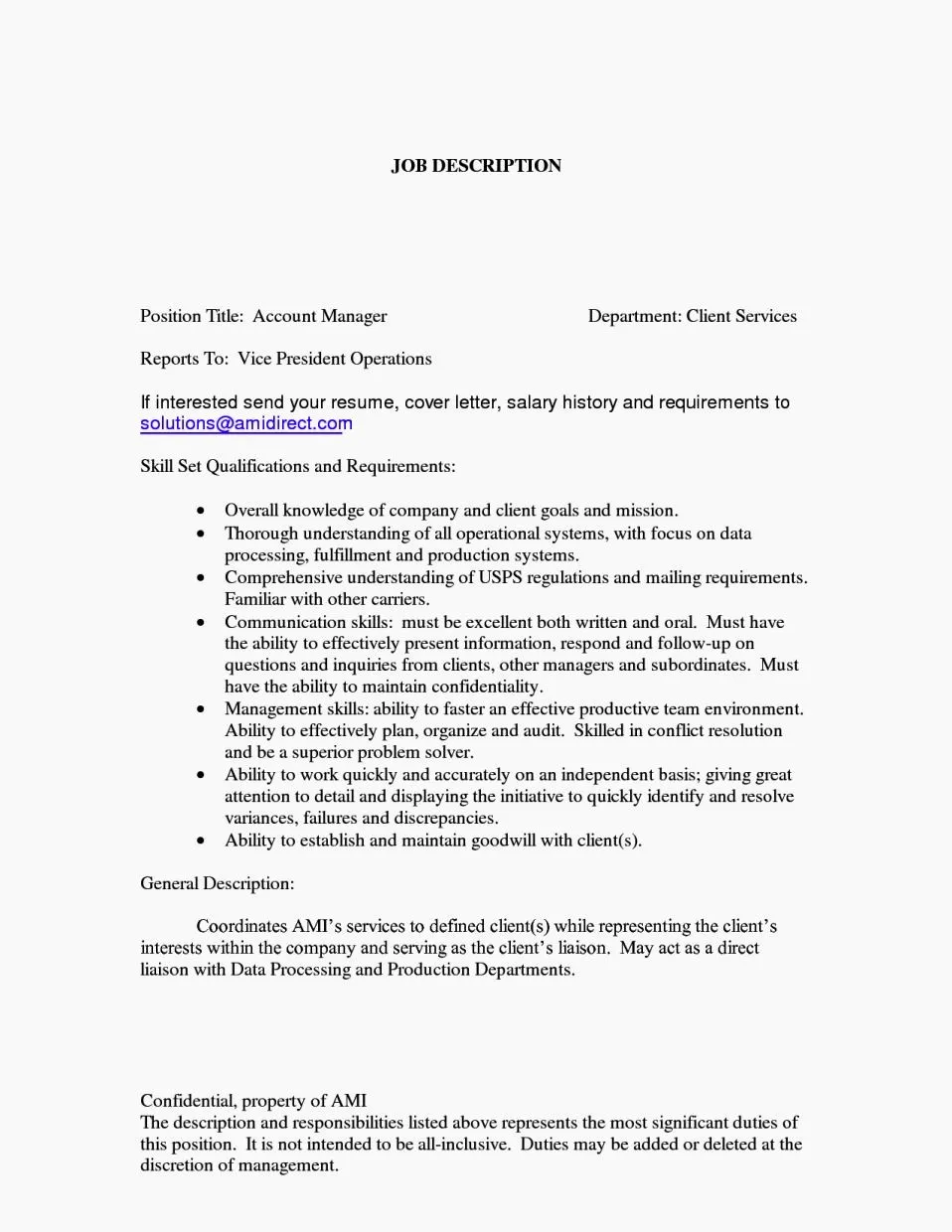Understanding the Salary History Cover Letter Why It Matters
In the world of job applications, the salary history cover letter serves as a crucial document, often requested by potential employers to understand your compensation expectations. While it might seem like just another piece of paper, its importance lies in shaping your initial impression and influencing the negotiation process. A well-crafted salary history cover letter can showcase your professionalism, assertiveness, and understanding of the job market, whereas a poorly written one could potentially cost you the opportunity. Understanding its purpose and structure is key to a successful job application. Many companies use this letter to ensure that applicants are in line with the company’s compensation structure, preventing potential issues down the line, and it also allows companies to gauge the applicant’s worth within the industry.
The Purpose of a Salary History Cover Letter
The primary purpose of a salary history cover letter is to provide employers with insights into your past compensation, but there is more to it than meets the eye. The letter allows you to frame your previous salary in the context of your experience and achievements, demonstrating how your skills have evolved. It also provides an opportunity to highlight how your desired salary aligns with the role and its responsibilities. Through the letter, you can express your salary expectations or, in some cases, respectfully decline to disclose this information, depending on the circumstances and legal requirements. The goal is to balance transparency with protecting your interests and presenting yourself as a confident candidate. By strategically addressing the salary issue, you can increase your chances of moving forward in the hiring process and ultimately securing a competitive offer that reflects your worth.
When You Need a Salary History Cover Letter
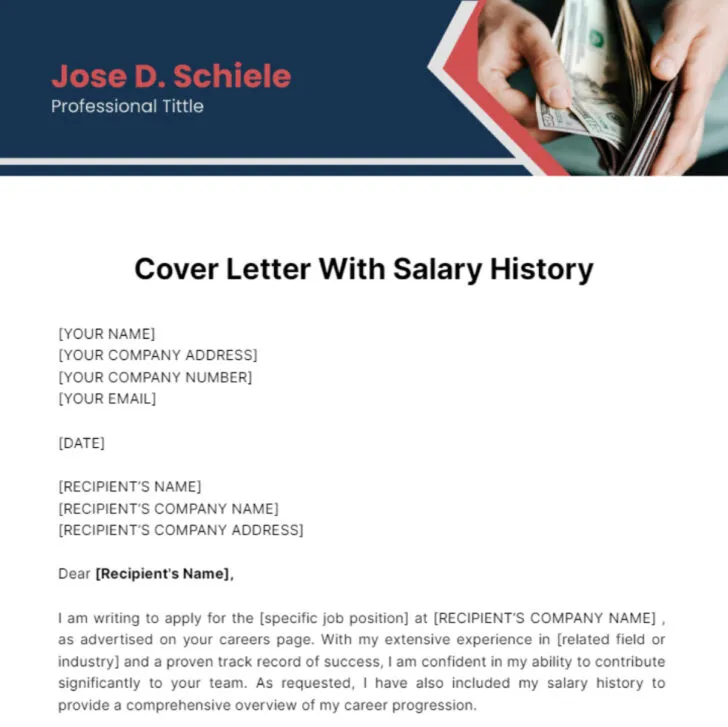
Determining when to include a salary history cover letter depends on the job posting and the company’s requirements. Many job applications explicitly request or require salary history information. In these cases, it’s essential to comply to avoid immediate disqualification. However, in some situations, disclosing your salary history may not be the best strategy. Some states and cities have enacted laws prohibiting employers from asking about an applicant’s current or previous salary. If you’re applying in an area with such regulations, it’s wise to understand the local employment laws. In these cases, you may choose to omit your salary history or provide a salary range instead. Consider the company culture, the job level, and the industry standards. If you’re unsure, it’s best to err on the side of caution and be prepared to address the topic, but always prioritize your career interests and legal compliance.
Key Components of a Powerful Salary History Cover Letter
A powerful salary history cover letter includes several essential elements designed to present you effectively. First, you must start with a professional opening section that grabs the reader’s attention and makes them want to read further. Next, highlight your relevant skills and experience to showcase your qualifications for the role, which helps connect your past salary to your current abilities. Then, quantifying your achievements, such as results from past roles, can make your value tangible. Finally, you must address salary expectations confidently, including providing a salary range based on your research. Always customize the letter to match the job description and the company’s values. By following these steps, you will show that you understand both the role and the industry, which makes you a more attractive candidate.
Opening Section Grab Their Attention
The opening section is critical in any cover letter, and a salary history cover letter is no exception. Begin with a strong statement that captures the hiring manager’s attention. You might start by expressing your enthusiasm for the position and quickly summarizing your key skills and experiences. Briefly mentioning why you are excited about the company can also show your genuine interest. Keep the opening concise and focused on the most relevant information. Always tailor the opening to the specific job and company to show that you have done your homework. This section sets the tone and encourages the reader to continue reading, which is essential to get the reader invested in your application. A well-crafted introduction can significantly boost your chances of making a positive impression.
Highlighting Your Relevant Skills and Experience
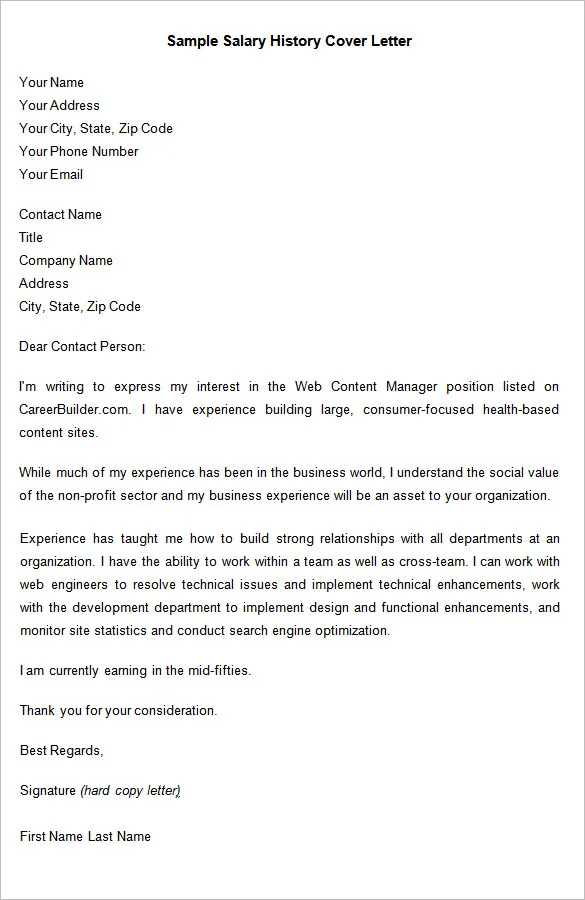
In the body of your salary history cover letter, focus on the skills and experience most relevant to the job description. Instead of listing all your past roles and responsibilities, select those that directly align with the employer’s requirements. Describe how your skills, learned from previous roles, translate to the new position. Use action verbs to illustrate your accomplishments and emphasize the impact of your actions. Consider using the STAR method (Situation, Task, Action, Result) to provide detailed examples of how you’ve used your skills. Tailor your examples to showcase how you will bring value to the company and why you are the best fit. Clearly linking your skills and experiences to the specific needs of the job increases your credibility and demonstrates that you are a good fit. This is where you highlight your value and persuade the employer to see you as a top contender.
Quantifying Your Achievements
To make your claims more persuasive, quantify your achievements whenever possible. Instead of just saying you “improved sales,” state the percentage increase or the dollar amount you generated. Quantifiable results add weight to your claims and prove your effectiveness. Use numbers and statistics to showcase your accomplishments. For instance, mention how you “reduced costs by 15% in one quarter” or “increased customer satisfaction scores by 20%.” This level of detail demonstrates that you understand how to deliver results and make a measurable impact. Ensure that the numbers and data you include are accurate and reflect your true contributions. Adding quantifiable results will show the hiring manager the direct value you can bring to the role and how you have been successful in previous positions.
Addressing Salary Expectations Confidently
Addressing salary expectations requires a balance of confidence and pragmatism. If the job posting requests a salary range, provide a realistic range based on your research. If the company asks for your salary history, you can share this information transparently, highlighting the context of your growth. However, if you prefer not to disclose this information, you might state that your salary expectations are negotiable or that they align with the market rates for the position. Avoid being vague, and make sure that your salary expectations are in line with your experience, the market rate for similar roles, and the company’s compensation structure. This is an opportunity to show that you are knowledgeable about industry standards. Frame your response in a way that expresses your value while remaining open to discussion.
How to Research Salary Ranges

Thorough research is essential to determining an appropriate salary range. Start by using online resources like Salary.com, Glassdoor, and LinkedIn Salary to gather data on similar roles in your area. Reviewing job postings to see the compensation packages can also provide valuable information. Consider your years of experience, skills, and education when evaluating the data. Also, factor in the company size, industry, and location, as these can influence salary levels. Be sure to consider the total compensation, including benefits and bonuses, when determining the appropriate range. During the process, be realistic and base your expectations on the collected research to come up with a range that is in line with your qualifications and the current job market. Properly researching the role will help you confidently discuss your salary requirements during the interview.
Negotiating Your Salary
The salary history cover letter sets the stage for salary negotiations. Approach this part of the application strategically. If you have the opportunity to negotiate, use the research you’ve gathered to justify your expectations. Focus on your value and the unique skills you bring to the role. Be prepared to discuss your previous compensation in the context of your achievements and how you will contribute to the company. Practice your negotiation skills and anticipate the questions the hiring manager might ask. Be confident and assertive. If the initial offer is lower than you anticipated, don’t be afraid to politely ask for more, using your research and value to support your request. Keep in mind that the negotiation should be a collaborative process, where both parties reach an agreement that is fair. By preparing and being confident in your value, you can negotiate a salary that reflects your worth.
Formatting and Design Tips for Your Cover Letter
The formatting of your cover letter reflects your professionalism. Ensure the letter is well-organized, easy to read, and visually appealing. Use a clear, professional font like Arial or Times New Roman, and maintain consistent font sizes throughout the document. Keep the letter concise, ideally no more than one page. Divide the content into clear paragraphs with appropriate headings and subheadings. Use bullet points to highlight key accomplishments and skills, enhancing readability. Maintain proper margins and spacing for a clean look. Always proofread your cover letter for any grammatical errors and typos. The goal is to present a polished and professional document that reflects well on your attention to detail. This is especially important in today’s competitive job market, where visual presentation is an important factor.
Template and Structure for a Cover Letter
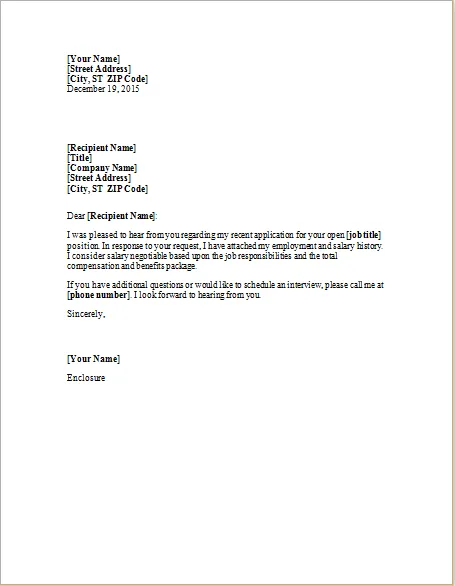
Use a clear and logical structure to organize your salary history cover letter. Start with your contact information, followed by the date and the employer’s information. Begin with a professional greeting, such as “Dear Mr./Ms. [Last Name]”. Your letter should include an opening paragraph stating your interest in the position and a summary of your qualifications. In the main body, highlight your skills and achievements and address the salary requirements or provide the requested information, and show that you have done your research. End with a call to action, restating your enthusiasm and expressing your willingness to discuss your qualifications further. Close with a professional closing such as “Sincerely” or “Best regards,” followed by your signature and typed name. Customize the template and structure to align with the specific job and company.
Proofreading and Editing Ensure Professionalism
Always proofread and edit your salary history cover letter to eliminate any errors. Typos, grammatical mistakes, and inconsistencies can damage your credibility. Use a grammar checker and spell-checker, but don’t rely on them completely. Proofread the document multiple times, and consider asking a friend or family member to review it. Pay close attention to your use of language, and ensure that your tone is professional and appropriate. Double-check all the details, including the employer’s name, job title, and company address. The more polished your cover letter is, the more professional you will seem to the hiring manager. This attention to detail shows your commitment to the application process. A well-edited cover letter increases your chances of making a positive impression and advancing your application.
Common Mistakes to Avoid in Your Cover Letter
Avoid common pitfalls to ensure your salary history cover letter effectively represents you. One major mistake is overstating your previous salary, which can cause issues during the verification process. Another is including irrelevant information that distracts the hiring manager from your core skills. Lastly, avoid failing to tailor your letter to the specific job and company, as this makes you seem generic and less interested in the position. Ensure you write concise, relevant content, and address only the necessary points. Avoid these mistakes to enhance your chances of making a positive impression and landing the job.
Overstating Your Previous Salary
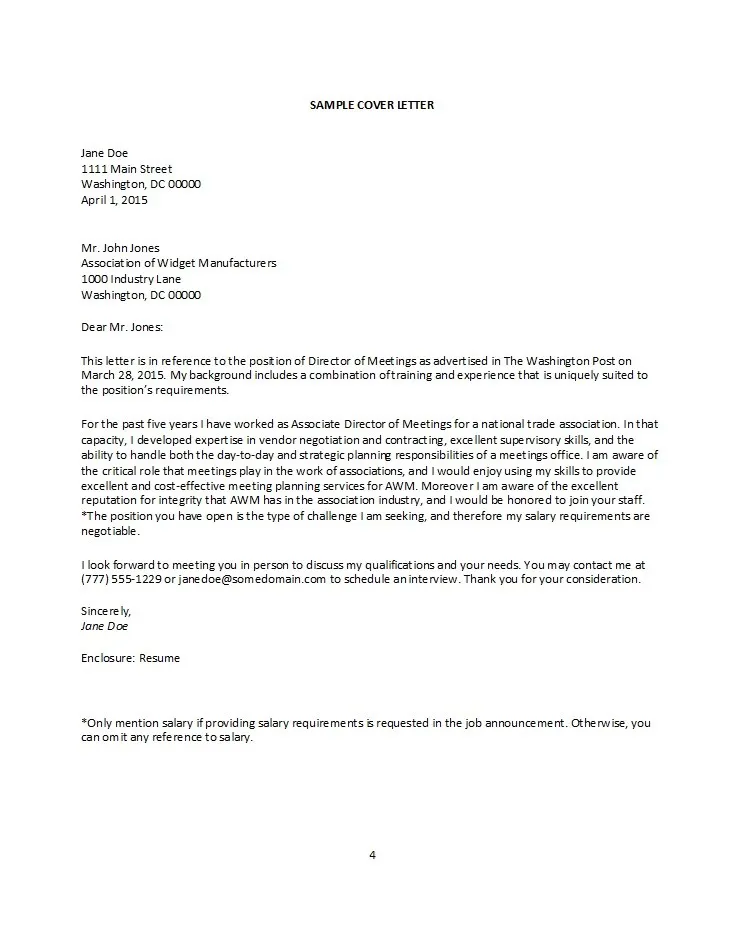
One of the most damaging mistakes is overstating your previous salary. Providing inaccurate figures can damage your credibility if the information is verified later. Honesty is the best policy. Instead of exaggerating your past earnings, emphasize the value and results you have delivered in previous roles. If you’re concerned about being underpaid, focus on your overall compensation and the benefits you received. Research industry standards to support your desired salary range and negotiate based on your skills and experience. Presenting yourself as an honest and ethical candidate will increase your chances of getting the job and building a strong professional relationship.
Including Irrelevant Information
Avoid including irrelevant information in your salary history cover letter. Keep your letter focused on what matters most to the job. Avoid including personal details, hobbies, or experiences unrelated to your professional qualifications. This is a business document, and it should be clear that you are a good fit for the role. Emphasize your relevant skills and experiences instead. Only include information directly related to the job requirements and your professional history. By maintaining a concise, job-focused approach, you show that you value the hiring manager’s time and are focused on the job’s specifics.
Failing to Tailor Your Letter
Failing to tailor your salary history cover letter to each job is a major mistake. Sending a generic cover letter suggests a lack of interest or effort. Take the time to customize the letter to the job and company. Always reference the specific job description and highlight how your skills and experiences align with the requirements. Use the company’s name, mention specific projects or initiatives, and show that you understand their values. Research the company to showcase your knowledge and enthusiasm. A tailored cover letter shows the hiring manager that you are genuinely interested in the role. The time spent on customization demonstrates your dedication and enhances your chances of success.
Best Practices for Salary History Disclosure
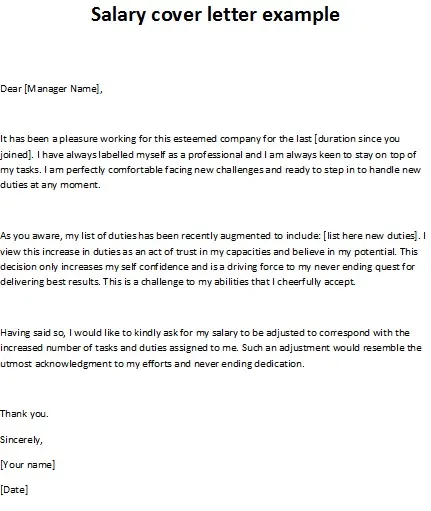
When disclosing your salary history, transparency is generally beneficial. Be prepared to provide accurate information and, if needed, explain the context of your salary. For instance, you may explain how your responsibilities and skills have evolved since your last role. If you’re concerned about your current salary being lower than the market average, focus on your achievements and the value you can bring to the new role. Make sure the data you provide is truthful and professional, which will help you navigate negotiations with a strong sense of trust. Always be prepared to show the value and expertise that you will bring to the position.
Handling Salary Negotiation
Salary negotiation is an essential part of the hiring process, and your salary history cover letter can set the stage for success. Prepare by researching the market rate for the role and knowing the value you bring. When discussing salary, remain professional and confident. Support your requests with data and examples. If the initial offer is below your expectations, be prepared to negotiate. Always express your interest in the position and reiterate your value. Be willing to discuss your needs, while keeping your expectations realistic. This will create a mutually agreeable compensation package. By negotiating well, you can increase your earning potential and demonstrate your worth to the company.
Salary History Cover Letter Examples and Templates
Using salary history cover letter examples and templates can be an excellent strategy to refine your writing style. They provide valuable insight into structuring the letter and showing your professional abilities. When reviewing examples, adapt them to your situation and skills. Tailor the examples to align with the job requirements, company, and industry to ensure relevance. You can also use templates as a starting point, then customize them with your own information. Adapt the content to reflect your unique accomplishments and experiences. By using these resources wisely, you can develop a cover letter that highlights your strengths, making a strong impression.
Example Cover Letter for a Senior Position
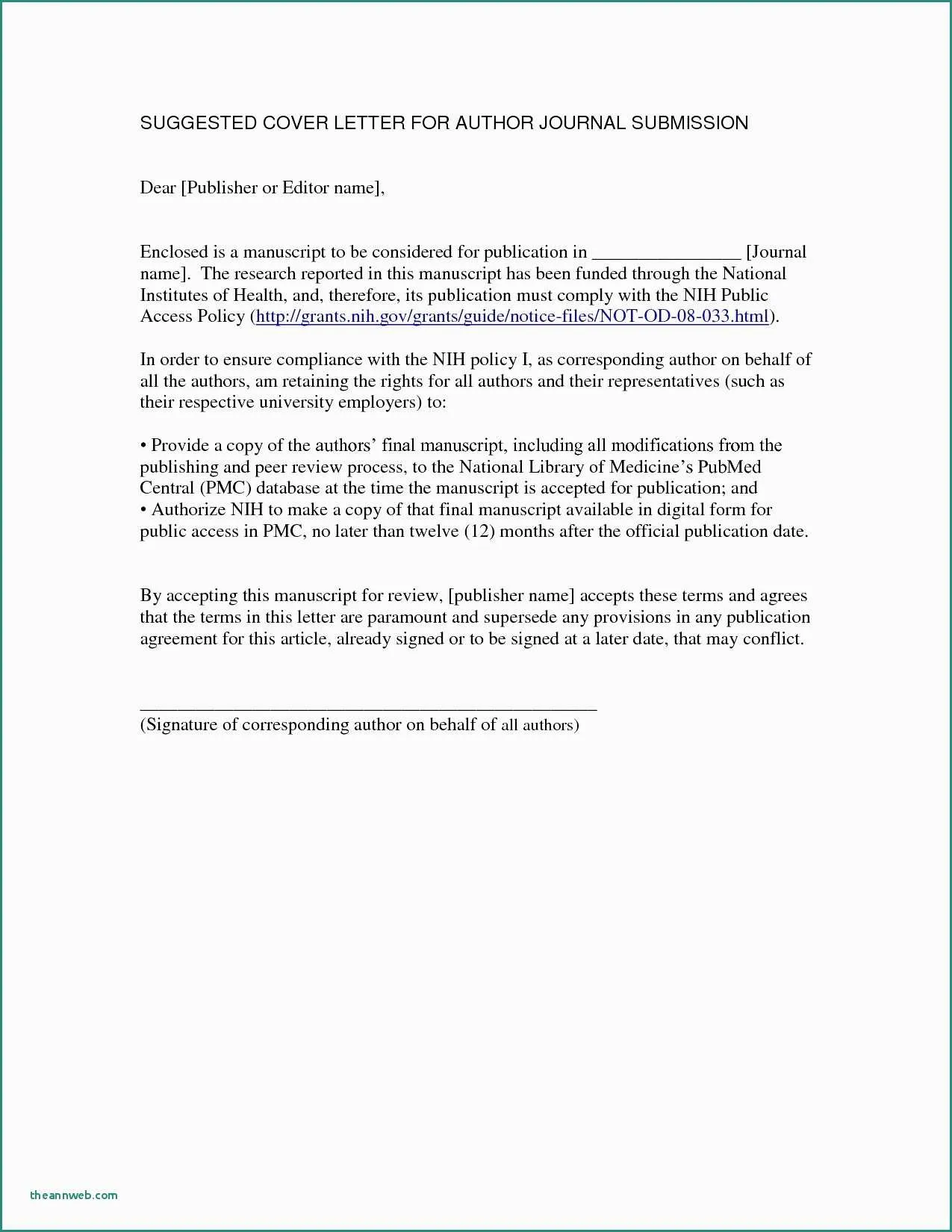
When applying for a senior-level role, your salary history cover letter should emphasize your experience and leadership skills. Begin by highlighting your previous experience and quickly outline the results you’ve achieved. Provide clear examples of the value you brought to past positions. Include any salary information, referencing the industry average for senior-level roles. Focus on the specific skills and accomplishments most relevant to the job requirements. Use strong action verbs and quantify your achievements. Also, address salary expectations, demonstrating that you have researched industry standards and are confident in your value.
Example Cover Letter for Entry-Level Position
For entry-level positions, your salary history cover letter should highlight your education, transferable skills, and enthusiasm. While you may have less experience, focus on how your skills and education align with the job description. Use examples from internships, academic projects, or volunteer work to showcase your potential. Address your salary expectations with an understanding of entry-level pay. It is also helpful to demonstrate that you have researched entry-level salary ranges. Express your eagerness to learn and contribute to the company. This approach is the best way to show you are a qualified candidate.
Example Cover Letter for a Career Change
If you’re making a career change, your salary history cover letter needs to focus on transferring your skills to a new role. Highlight your transferable skills, and explain how these skills can be applied in the new role. Focus on the value of your experiences and accomplishments, emphasizing how they are relevant to the new career path. Address your salary expectations, recognizing that your previous salary might not directly reflect your current potential. Showcase your willingness to learn and adapt. Use the cover letter to explain your career change, emphasizing your enthusiasm for the opportunity, and your commitment to success.
Final Thoughts and Next Steps
Writing a powerful salary history cover letter requires thorough preparation and strategic thinking. By understanding its purpose, following best practices, and avoiding common mistakes, you can significantly increase your chances of landing the job. Remember to tailor your letter to each job, highlight your accomplishments, and always proofread. Your next steps should include researching salary ranges, practicing your negotiation skills, and preparing for the interview. Approach the application process with confidence. Use the techniques outlined in this guide to create a compelling and successful cover letter. By doing so, you can make a positive impression and increase your career opportunities.
